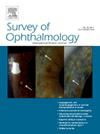缓解全视网膜光凝疼痛的药物治疗:随机对照试验的网络荟萃分析。
IF 5.9
2区 医学
Q1 OPHTHALMOLOGY
引用次数: 0
摘要
贝叶斯网络荟萃分析(NMA)可以帮助比较用于减轻全视网膜光凝疼痛的各种镇痛药和麻醉药。我们进行了一项系统综述和网络荟萃分析,以评估药物干预对缓解全视网膜光凝(PRP)患者疼痛的作用。我们纳入15项随机对照试验和4项交叉试验,共1787只眼,45.83%的参与者为女性。参与者的平均年龄为55岁。与安慰剂相比,2%的球周利多卡因是唯一显著的治疗方法(MD -2.4 (95% CrI -4.7 -0.20))。秩概率和SUCRA也显示2%球周利多卡因(0.887)是降低疼痛评分的最佳治疗方案,其次是依托昔布(0.809)和双氯芬酸钾(0.727)。与全身和局部用药相比,2%的球周利多卡因可有效减少激光治疗中的程序性疼痛。未来的研究应该评估能够到达并作用于眼后段的药物。本文章由计算机程序翻译,如有差异,请以英文原文为准。
Pharmacological therapy for relieving pain in panretinal photocoagulation: A network meta-analysis of randomized controlled trials
A Bayesian network meta-analysis (NMA) can help compare the various types of analgesics and anesthetics used for lowering pain of panretinal photocoagulation. We carried out a systematic review and network meta-analysis to assess pharmacological interventions for relieving pain in patients undergoing panretinal photocoagulation (PRP). We included 15 randomized controlled trials and 4 crossover trials with a total of 1787 eyes and 45.83 % of the participants were female. The mean age of the participants was 55 years. 2 % peribulbar lidocaine was the only significant treatment compared to placebo (MD −2.4 (95 % CrI −4.7 to −0.20). The rank probability and SUCRA also revealed 2 % peribulbar lidocaine (0.887) as the best treatment in terms of lowering the pain scores followed by etoricoxib (0.809) and potassium diclofenac (0.727). Two per cent peribulbar lidocaine is effective for reducing procedural pain in laser treatment compared to systemic and topical medications. Future studies should evaluate drugs that can reach and act on the posterior segment of the eye.
求助全文
通过发布文献求助,成功后即可免费获取论文全文。
去求助
来源期刊

Survey of ophthalmology
医学-眼科学
CiteScore
10.30
自引率
2.00%
发文量
138
审稿时长
14.8 weeks
期刊介绍:
Survey of Ophthalmology is a clinically oriented review journal designed to keep ophthalmologists up to date. Comprehensive major review articles, written by experts and stringently refereed, integrate the literature on subjects selected for their clinical importance. Survey also includes feature articles, section reviews, book reviews, and abstracts.
 求助内容:
求助内容: 应助结果提醒方式:
应助结果提醒方式:


